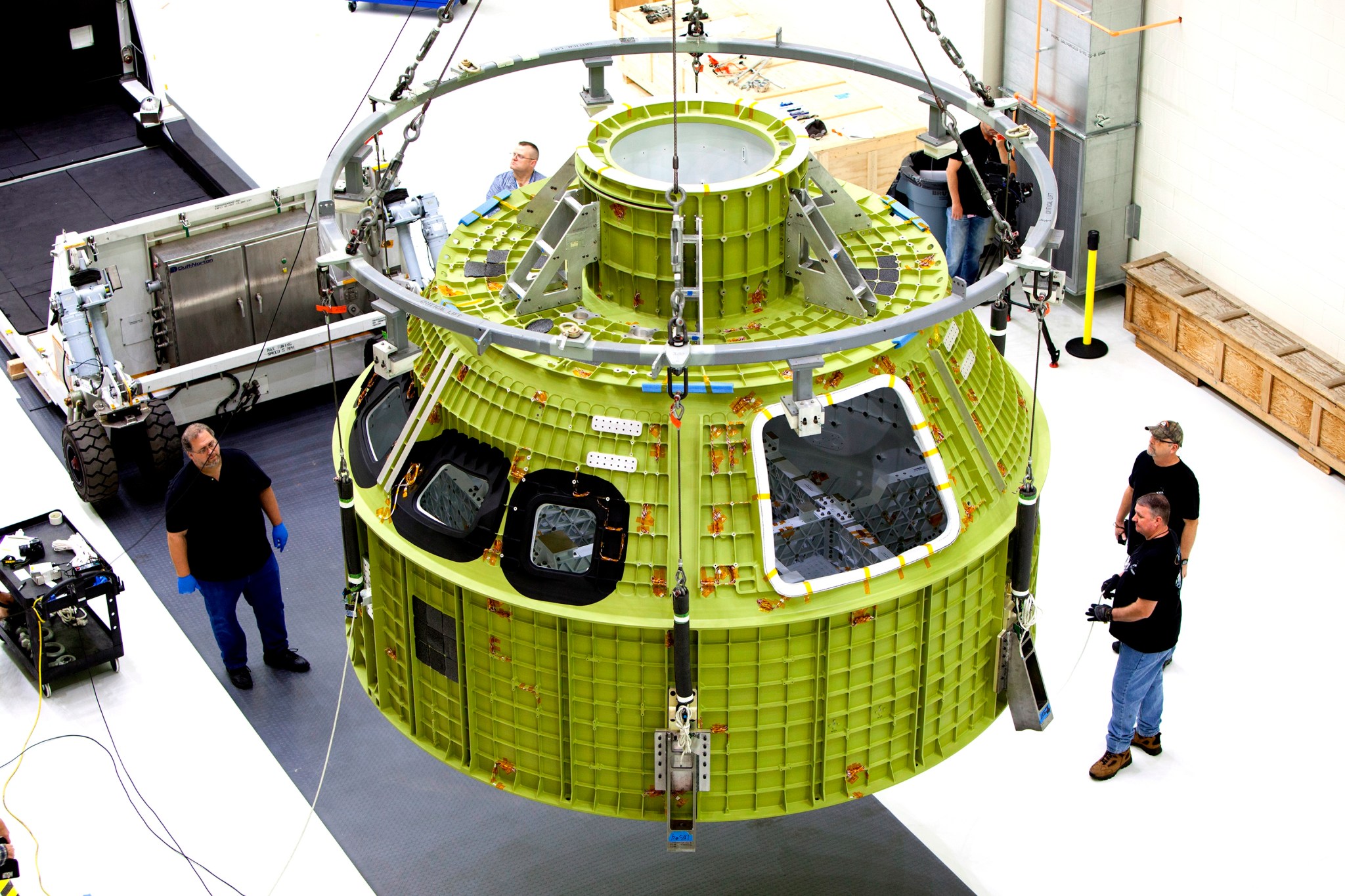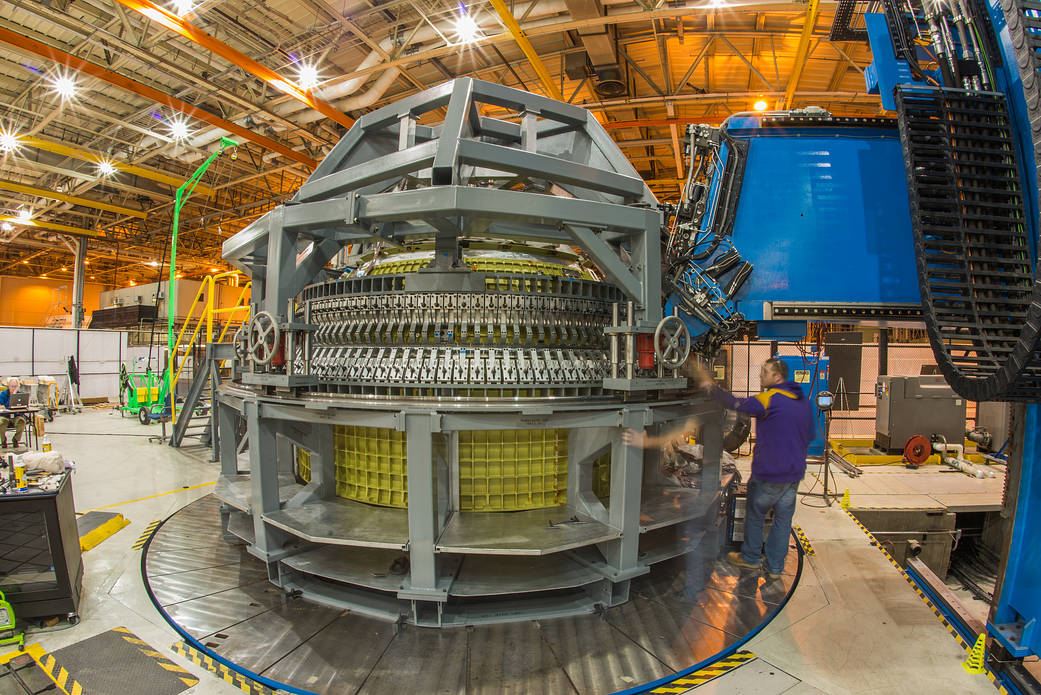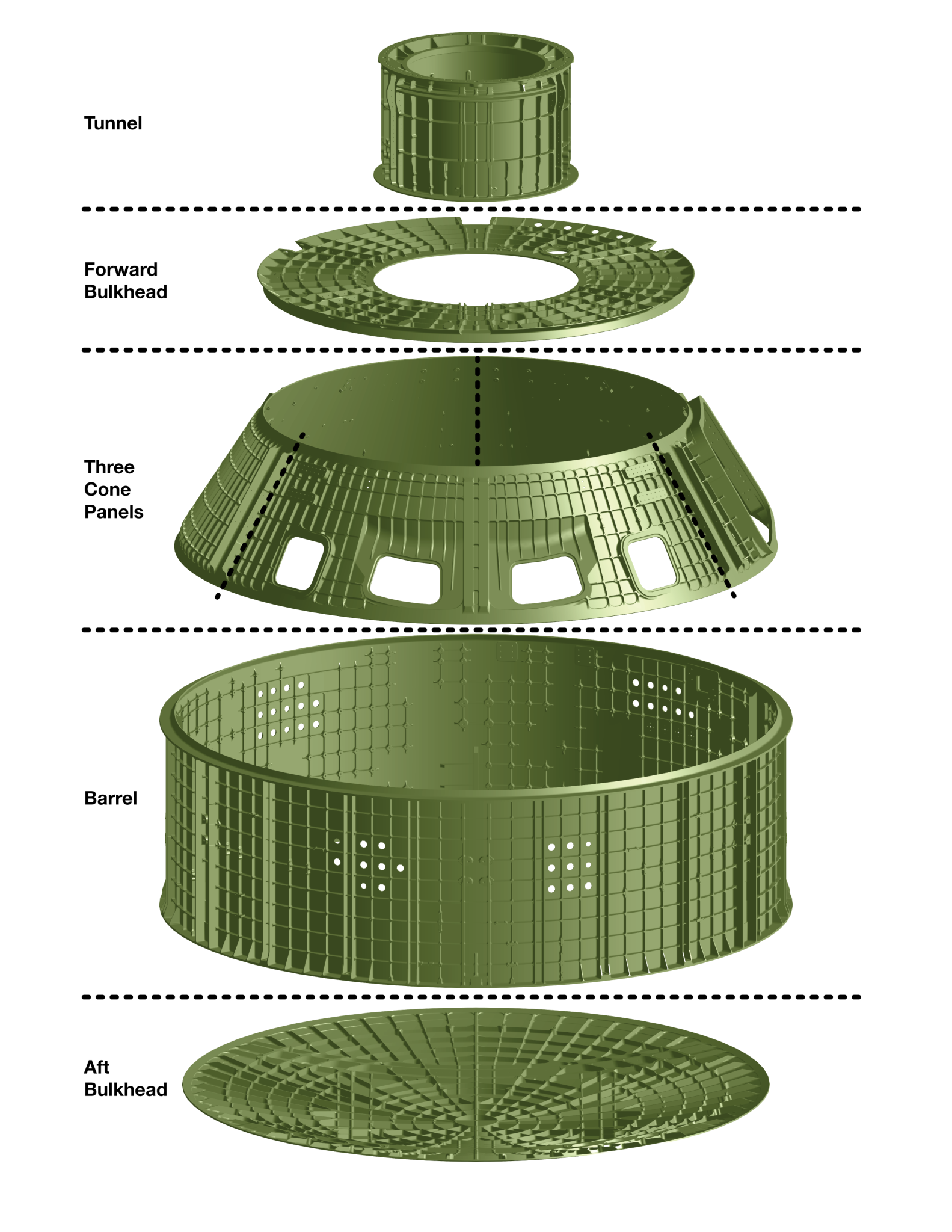Michoud Assembly Facility
For more than half a century, NASA’s Michoud Assembly Facility in New Orleans has been the agency’s rocket factory and the nation’s premiere site for manufacturing and assembly of large-scale space structures and systems. The government-owned manufacturing facility is one of the largest in the world, with 43 acres of manufacturing space under one roof. Michoud is managed by NASA’s space under one roof. Michoud is managed by NASA’s with several areas of the facility used by commercial firms or NASA contractors. Manufacturing and assembly of some of the largest parts of NASA’s Space Launch System and Orion spacecraft take place at this facility.

Crew Module Pressure Vessel
Orion’s crew module pressure vessel, the underlying frame of the crew module that provides an air-tight, habitable space for astronauts during the mission, is assembled at Michoud by prime contractor Lockheed Martin. The pressure vessel is designed to withstand the harsh and demanding environment of deep space and is the core structure upon which all the other elements of Orion’s crew module are integrated. The pressure vessel’s exterior is comprised of seven large aluminum alloy elements that are manufactured by two key subcontractors, AMRO Fabricating Corp. in South El Monte, CA and Ingersoll Machine Tools in Rockford, IL. AMRO provides the pressure vessel’s three cone panels and Ingersoll provides the barrel, tunnel, forward and aft bulkheads.
Once all the elements arrive at Michoud, they are welded together in detailed fashion. The cone panels are joined with three welds to form the angled mid-section of the pressure vessel where the windows and hatch are located. pressure vessel where the windows and hatch are located. bulkhead, which is at the top of the spacecraft and houses many of Orion’s critical systems, such as the parachutes that deploy during entry into Earth’s atmosphere. Orion’s tunnel, with a docking hatch, will allow astronauts to move between the crew module and other spacecraft. The spacecraft’s barrel section, which is the largest single piece of the spacecraft, is welded to the aft bulkhead, which is the bottom portion of the vehicle, in order to form the aft structure. Technicians install Orion’s backbone inside the aft structure.

The backbone assembly is a bolted structure consisting of nine pieces that are assembled prior to being installed inside the pressure vessel. The forward bulkhead is welded to the top of the cone panels in what is called the forward structure weld. The seventh and final major structural weld, also called the closeout weld, combines the forward and aft structures to complete the pressure vessel. Once welding of the crew module’s pressure vessel is complete, it is shipped to NASA’s Kennedy Space Center where it undergoes further assembly.
The Orion crew module pressure vessel is joined using a method called friction-stir welding. Friction-stir welding produces incredibly strong bonds by transforming metals from a solid into a “plastic-like” state, and then using a rotating pin tool to soften, stir and forge a bond between rotating pin tool to soften, stir and forge a bond between vital requirement of next-generation space hardware.

The technique is also being used at Michoud to weld the massive barrels of the SLS core stage to make the more than 200-foot tall structure.
Engineers undertake a meticulous process to prepare for welding. They clean the segments, coat them with a protective chemical and prime them. They then outfit each element with strain gauges and wiring to monitor the metal during the fabrication process. Prior to beginning work on the pieces destined for space, technicians weld together a pathfinder, a full-scale version of the current spacecraft design, in order to refine their techniques and ensure proper tooling configurations.
The pressure vessel for Artemis I was completed at Michoud in January 2016, and the pressure vessel for Artemis II was completed in August 2018. The Artemis III pressure vessel was completed in September 2021.
Seven Welds of Orion’s Pressure Vessel
| Pressure Vessel Cone | |
| PVC-1 | D-E (hatch) to A-F (windows) cone weld |
| PVC-2 | A-F to B-C cone weld |
| PVC-3 | B-C to D-E cone weld |
| Pressure Vessel | |
| PV-1 | Tunnel to forward bulkhead weld |
| PV-2 | Forward bulkhead to top of cone panels weld (becomes the forward structure) |
| PV-4 | Barrel to aft bulkhead weld (becomes the aft structure) |
| PV-3 | Closeout weld – forward structure to aft structure weld (bottom of cone panels to barrel) |
Other Orion Components
Work on Orion structures at Michoud goes beyond assembling the pressure vessel. The team provides design, manufacturing, assembly, integration, and test capabilities or key elements of Orion.
Other work on the crew module includes fabricating 227 Avcoat billets (117 standard blocks, 57 thick blocks, 53 curved blocks) that will be used to make the heat shield. The wall panels for the crew module’s environmental control and life support systems (ECLSS) are also laid up, assembled, and tested at this facility. The assembly and testing of the module’s docking hatch also takes place here, as well as the assembly of the four crew seats.
Work on the service module at Michoud includes laying up, trimming, assembling and testing 22 panels (six aft, six forward, seven outboard, and three access covers) for the crew module adapter, which will connect the service module to the crew module. The trimming, assembly, and testing of three spacecraft adapter jettison panels, which will protect the service module from the environment during ascent, also takes place here. The same is done for the spacecraft adapter cone, which connects to the bottom of the service module and will later join another adapter connected to the top of the rocket’s interim cryogenic propulsion stage (ICPS).
Structural components of the launch abort system (LAS) are assembled at Michoud, including two fillet panels, the motor adapter truss assembly, which connects the crew module to the LAS, and four ogive panels. The fillet and ogive panels also undergo testing here. LAS tower components assembled at Michoud include the nose cone and aft and forward interstage, the latter of which is also tested. Components of the raceway, which runs the electronic communication lines through the system, are assembled here, including eight raceway covers, and 24 access covers. Eighteen aero seals and 12 tangential fittings are also assembled at Michoud.



























